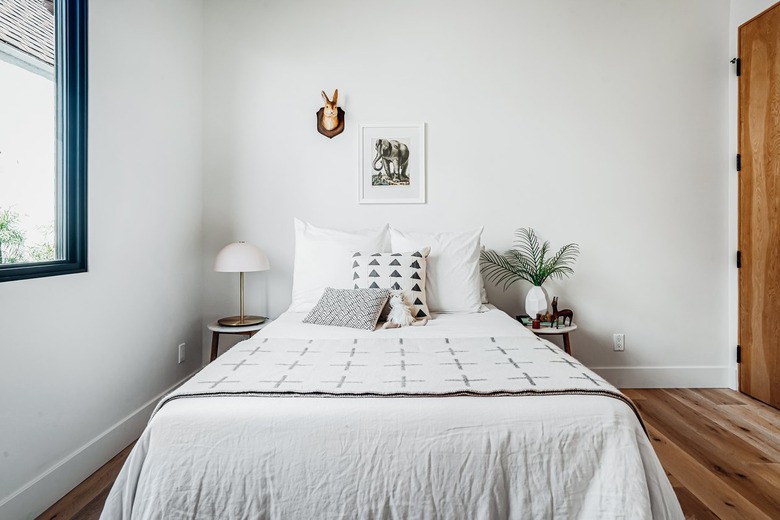Why Is My Room So Dusty? 5 Causes — And Some Easy Fixes
We may receive a commission on purchases made from links.
Even if you consider yourself a neat freak with all the best dusting techniques, it's likely that you still have a few dust bunnies floating around your house. Controlling household dust particles is no easy task — and to be effective, you need to understand not only where the dust in your home originates, but also apply the appropriate prevention and cleaning techniques. That doesn't mean it should be a labor-intensive project, however. With the right adjustments, most dust control will take care of itself (yes, you read that right).
Why Is My Room So Dusty? 5 Causes
Why Is My Room So Dusty? 5 Causes
1. Outside Contaminants
It feels great to open the windows and let some fresh air into your home, but that air may not come alone. Outdoor air is full of dirt and pollen particles small enough to fit through your window screens. Even if you keep your windows closed, the same gaps and cracks that let your heat escape in the winter can let in outside dust all year.
The dust can follow you home as well. Whenever your family comes back inside, there are likely to be many dirt, dust, and pollen particles stuck to them and their clothes. The same is true of your pet's paws. The world is a dusty place, and we bring some of that with us when we come home.
2. Hair and Skin
You shouldn't dwell on the idea if you're squeamish, but the truth is that all living things shed. Every living person walks around dropping dead skin cells and hair everywhere, and a great many of them collect in our homes as we spend time there. No matter how meticulously clean you are, you drop millions of dead skin flakes in your wake every day and so does everyone else in your family.
3. Pet Dander
Even if you go for short-haired varieties, your pets are continuously shedding fur and dead skin cells, too. Pet dander contributes to dust, and the more pets you have, the more pet dander and dust you'll need to deal with. Apologies to the squeamish again, but it's not just pets that bring animal dander into your home — so can uninvited pests, like rodents. If you think you have an issue, get it checked out.
4. Bedding and Fabrics
Humans spend about a third of their life in bed, so it's not much of a surprise to discover that our beds are full of the aforementioned dead skin cells. Beds are also shrouded in sheets, comforters, and blankets that create dust as they slowly deteriorate over time.
Fabrics — like upholstery, bedding, clothing — and even carpet, all create dust problems in two ways. One is by grabbing hold of dust and hanging on to it. The result is that a little dust is released every time the article is disturbed. Fabric and fibers also create dust as they age, losing tiny pieces of fiber slowly as they deteriorate and wear.
5. HVAC Woes
Although not always the case, HVAC issues can increase the amount of dust in your home. Sometimes, the problem is as simple as a dirty air filter that needs replacing, but more serious issues can occur. Your air ducts themselves can collect dust, in which case they may be blowing dust particles through your house.
HVAC leaks can also create dust problems. HVAC systems run along basement ceilings, through walls, and in other parts of your home that you can't access for easy cleaning. A crack or leak may draw in air from these dirty places and carry dust and dirt to other parts of your home.
How Can I Make My Room Less Dusty? 8 Tips
How Can I Make My Room Less Dusty? 8 Tips
Even if you bust out the duster every day, the truth is that you'll never get rid of dust particles completely. Luckily, there are several steps you can take to reduce their presence in your home. Not only will doing so help keep your home looking cleaner for longer but it can also reduce health issues. Dust is known to increase the frequency of asthma attacks and is a problematic allergen for some people.
References
1. Get a doormat.
To help reduce the amount of dust and dirt carried inside by way of your shoes, place a heavy-duty welcome mat outside your door and encourage guests to use it before coming in. You may also want to have family members and guests remove their shoes before coming inside. Place a small rug or runner inside the door as well to capture any dust the welcome mat misses.
2. Get things organized.
Dust loves clutter, so get rid of it. Dispose of or donate items you don't need and keep knickknacks and tchotchkes to a minimum. Box items stored on closet shelves to keep dust out of them and keep the floor clear so it is easier to vacuum. Clothes constantly shed dust as their fibers deteriorate, so store clothes you rarely wear in garment bags so they don't cause or collect dust in your closet.
You can also reduce dust by making sure your clothes make it into dressers and closets. It's easy to do the laundry and then forget to put it away. Living out of a laundry basket is not the best for organization or for controlling dust.
3. Change your bedsheets often.
Because it collects dead skin cells while you sleep and fibers from sheets and blankets, your bed is a major source of dust in your home. To reduce dust, change your bedsheets once a week. When removing the old sheets, roll them up and handle them gently to avoid shaking the dust out of them on the way to the washing machine. Take pillows and dry-clean-only blankets outside for a good shake rather than running them to the cleaners once a week.
4. Keep your pets in check.
Minimize the amount of dust generated by shedding pets by brushing dogs and cats regularly and bathing them periodically. Your vet can tell you how often to bathe your pet and what shampoo to use based on your pet's breed and skin traits. Covered cat litter boxes also reduce dust.
If you see a mouse or hear what might be a squirrel in the attic, call an exterminator and have them check things out right away. Uninvited guests can bring in unwanted animal dander just as readily as pets and may bring other problems as well. Nip pest problems in the bud before you discover that all that dust was a massive family of rats chewing through your insulation.
5. Close the windows.
Pollen, dirt, and dust from outside enter homes through open windows. The holes in most screens are large enough to let in the dust particles, so keeping your windows closed will help prevent dust. If you crave fresh air, consider purchasing special filtering screens that can help remove dust in the air.
Don't forget to caulk as well. Sealing any cracks and holes will help reduce your energy costs while helping to keep dust under control. You can also use fresh weatherstripping around your doors.
6. Eliminate static electricity.
Static electricity helps dust cling to the surfaces in your home, so dry air draws dust toward your furniture and helps it stay there. Use a humidifier to fix this problem. A relative humidity of 40 to 50 percent is best for eliminating dust. Place the humidifier in the dustiest room of your home or purchase and install a whole-house model.
7. Ditch the carpet.
It might feel good on your bare feet, but carpet is a dust magnet. Even with a high-quality vacuum cleaner, it is difficult to get out all of the dust that settles into a carpet. Removing carpeting from your home will reduce the amount of dust.
8. Filter what you can.
A great way to reduce dust is to catch it and trap it in filters. Make sure the filters on your heating and air conditioning units are clean and change them as recommended by your equipment manufacturer. Use a vacuum cleaner with a HEPA filter to help catch dust particles and hold them. Many vacuum cleaners simply redistribute dust rather than truly capturing it. Household air purifiers can also help reduce the amount of dust in your home.


